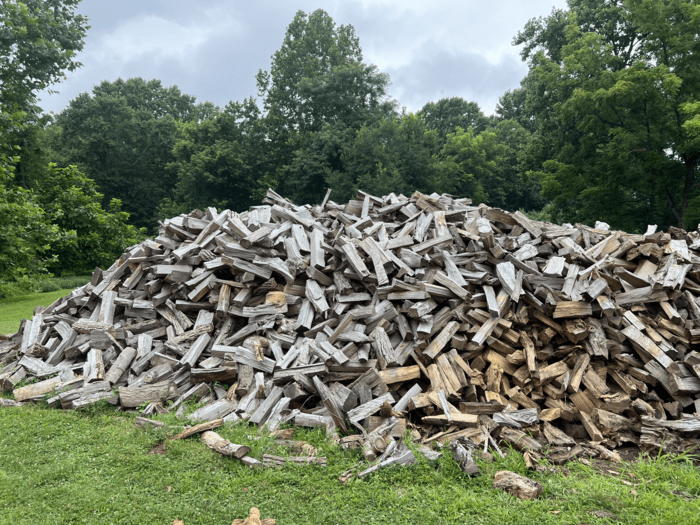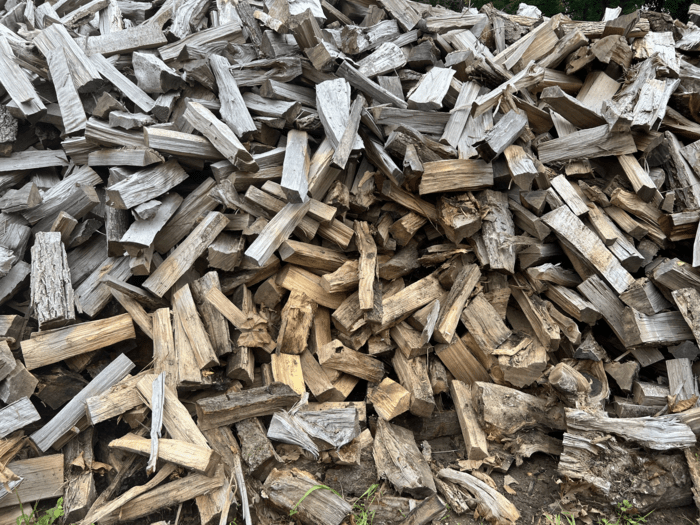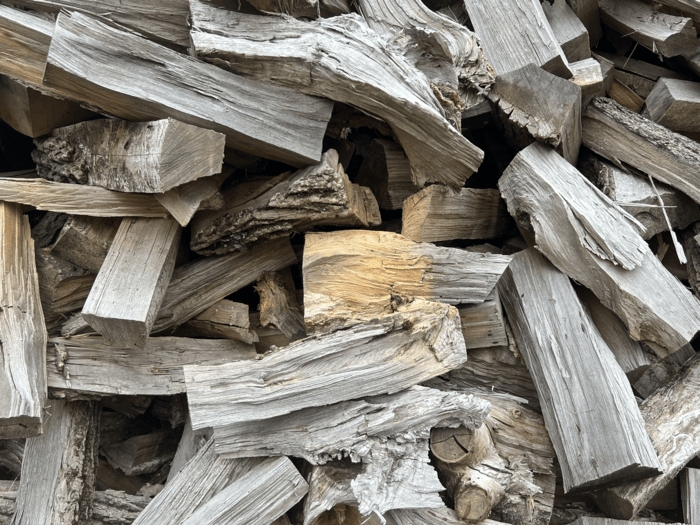When it comes to firewood, it doesn’t always make sense to carefully stack everything you split. Especially when you’re splitting several chords at a time! We sell firewood and stacked this pile for this winter:

As you can see, that’s a solid amount of firewood. And you may notice that the outside of the pile is a lighter color than than the wood on the bottom right. So, does DOES dry in a pile, right? While some wood has dried, it doesn’t mean that all the firewood has dried properly and evenly in this pile.
When firewood is thrown in a pile, the wood on top and the sides are exposed to air and sunlight, which makes it dry faster than the wood on the inside. Moisture in the firewood is trapped inside the pile due to low airflow. This slows down the drying process and leads to unevenly dried firewood.
See how firewood dries unevenly in a pile.
I stripped away some of the outside layer of my firewood pile to show you what I mean. The wood on the outside was grey and very light, which indicates it dried nicely. However, as I went about two pieces of wood deeper into the pile, this is what I found.

The wood was closer to the color of wet firewood. It wasn’t heavy like green wood, but noticeably less dried than the wood on the outside. This isn’t great. I only have a few months left for this wood to dry before winter comes.
Bear in mind, this wood has been sitting for a few months. Given more time, the wood on the inside of the pile will dry more and more. It’ll take much longer to dry the deeper you go in the pile because the moisture is trapped by the many layers of wood, and the airflow needed to dry properly is restricted. This is why it’s so important to properly stack your firewood before you use it.
Even wood near the outside of the pile dries unevenly.
Something really interesting I noticed is that even the wood on the outside of the pile dries unevenly. The sides of the wood exposed to the sun and proper airflow dried faster than side faced down. See for yourself:

I pulled a piece of wood out of the pile, and the part that was covered was noticeably less dry than the part of the piece that wasn’t covered.
The piece that was on top of this piece prevented airflow and sunlight from drying the wood underneath. It also trapped moisture in the wood underneath.
This is why firewood thrown in a pile will dry unevenly. If you stack wood and allow airflow on all sides, it will dry much faster and more evenly than firewood thrown in a pile.
If it does slower, why do you pile up firewood?
It’s a fair question. Most commercial firewood suppliers leave their firewood in a large pile instead of stacking it. The reason why is because of the time it takes to stack it.
My dad always says, “Firewood is bad business because of how many times you have to touch it.” You have to section the logs with a chainsaw, chunk them into quarters with a wedge, split the chunks with a log splitter, throw them in a pile, throw it in your truck bed, and deliver it.
Each step takes a bit of time and manpower, which lowers your margin when selling firewood. If every supplier took the time to properly stack their wood, firewood would cost even more. That’s why dried firewood sells for more, and we expect buyers to properly stack their wood when they buy it let it fully dry.
How can firewood thrown in a pile dry faster?
My setup is far from the best. We have a muddy piece of land where we dump hardwood logs we get from various tree removal jobs, where we later chunk, split, and pile the firewood to sell. We’re contractors, not firewood salesmen, which is why we don’t take this part of the business too seriously.
However, if you want to sell firewood, I recommend you take some steps to make your pile dry faster to sell higher-quality wood. Here’s what I’d do:
Pile your firewood on an elevated concrete pad.
You don’t want water to puddle under your firewood, which is a problem we run into. You want to stack your firewood so that water flows out of the pile, which could be an elevated pad or land with a slight decline.
It becomes a mud put under our firewood, which leads to us digging logs pressed into the mud as we get through the pile. The weight of the pile presses the bottom pieces down and rain turns that ground into mud, which ruins our bottom layer of firewood. It’ll rot and won’t be any good when we turn to sell it, this is what we end up using personally.
Make smaller piles of firewood.
Smaller piles of wood will allow more moisture to escape each pile, allow for better airflow, and have more wood exposed to the sun. However, this will take up much more room than one, large pile. If you have the space, I say go for it!
